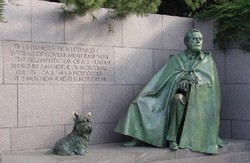Franklin Delano Roosevelt Memorial
|
| updated |
Copy Link Code
|
 In April 1945, World War II was coming to an end. The allied armies had developed a plan to invade Germany, but in Washington, D.C., President Franklin Roosevelt's health was in rapid decline. Family and friends were increasingly worried that he was becoming too frail to continue with presidential duties. FDR decided that he needed some time to rest and recuperate, so he traveled to his favorite "Little White House" located in Warm Springs, Georgia, a health spa with healing mineral waters he often frequented. A large group of friends and family accompanied Roosevelt, all anxious to enjoy two weeks of relaxation. As was his preference, the entourage traveled on the Ferdinand Magellan (also known as U.S. Car. No. 1), the presidential train.
In April 1945, World War II was coming to an end. The allied armies had developed a plan to invade Germany, but in Washington, D.C., President Franklin Roosevelt's health was in rapid decline. Family and friends were increasingly worried that he was becoming too frail to continue with presidential duties. FDR decided that he needed some time to rest and recuperate, so he traveled to his favorite "Little White House" located in Warm Springs, Georgia, a health spa with healing mineral waters he often frequented. A large group of friends and family accompanied Roosevelt, all anxious to enjoy two weeks of relaxation. As was his preference, the entourage traveled on the Ferdinand Magellan (also known as U.S. Car. No. 1), the presidential train.
On April 12, as FDR sat in the living room, signing documents and letters, an artist painted his portrait nearby. The atmosphere in the room was congenial and the conversation lively. Roosevelt reminded the artist that they only had fifteen minutes left for the sitting. Suddenly, President Roosevelt grabbed his head, complaining of a severely sharp pain and passed into a coma. Three months after being sworn in for his fourth term as president, Franklin Delano Roosevelt died of a cerebral hemorrhage at the age of sixty-three.
The funeral procession from Roosevelt's cottage traveled through Georgia Hall, where his fellow patients at the springs always gathered to wave goodbye to FDR. This day, there were tears instead of smiles, as Marines lined the roadways and streets where ordinary citizens usually waited to see the man with whom they shared a bond of physical affliction and perseverance. In the distance, Graham Jackson, a black man with an accordion, played "Going Home." He had played privately for FDR many times at the president's request. The farewell was final, the loss permanent.
Roosevelt's casket was first brought to Washington, D.C. on the "funeral train," where it was met at Union Station by thousands of mourners. After a memorial service in the White House, Roosevelt's body was carried by the train to his family home in Hyde Park, New York for burial. On the funeral train rode Eleanor, two of their children, the newly sworn-in President Harry Truman, all the Supreme Court justices and Roosevelt's cabinet. In total, it took three days to bring the president to his internment. One person's account describes it this way:
Not only was this 1050 mile journey a show of admiration for the president, judging by the tens of thousands of Americans who lined the tracks to pay their last respects, it was also a measure of the man who lay in a flag-draped coffin visible through the windows of the funeral train.The world was also in mourning at the loss of a president who had advocated a message of freedom for all people. Joseph Stalin had Roosevelt's picture and the story of his death printed on the front pages of Russian newspapers which was commonly reserved for government news; Winston Churchill cried as he delivered a speech about FDR's death to the House of Commons.
The Franklin D. Roosevelt Memorial
Dedicated on May 2, 1997 by President Bill Clinton, the Roosevelt Memorial covers over seven acres in Washington, D. C. The park setting has four separate galleries, each one representing a term of Roosevelt's presidency; waterfalls create a sense of peace and calm in recognition of Roosevelt's ability to bring the same feelings to the American people.
Ten bronze sculptures of FDR and Eleanor, as well as huge stones engraved with some of Roosevelt's most well-known quotes, fill the grounds of the memorial. The Franklin Roosevelt Memorial is the first designed to be wheelchair accessible and to accommodate other physical impairments; one section is carved in Braille so that the blind are able to read about him.
